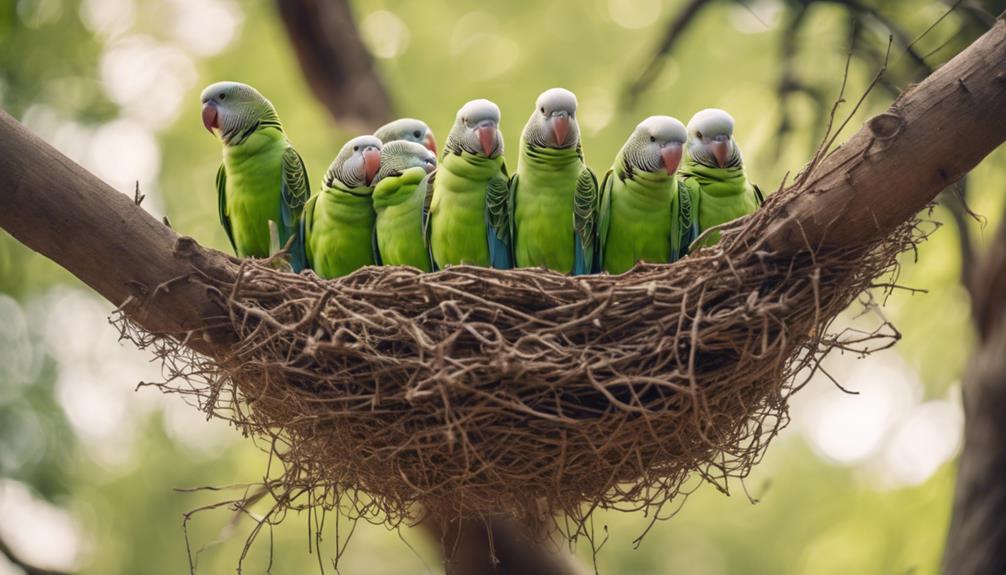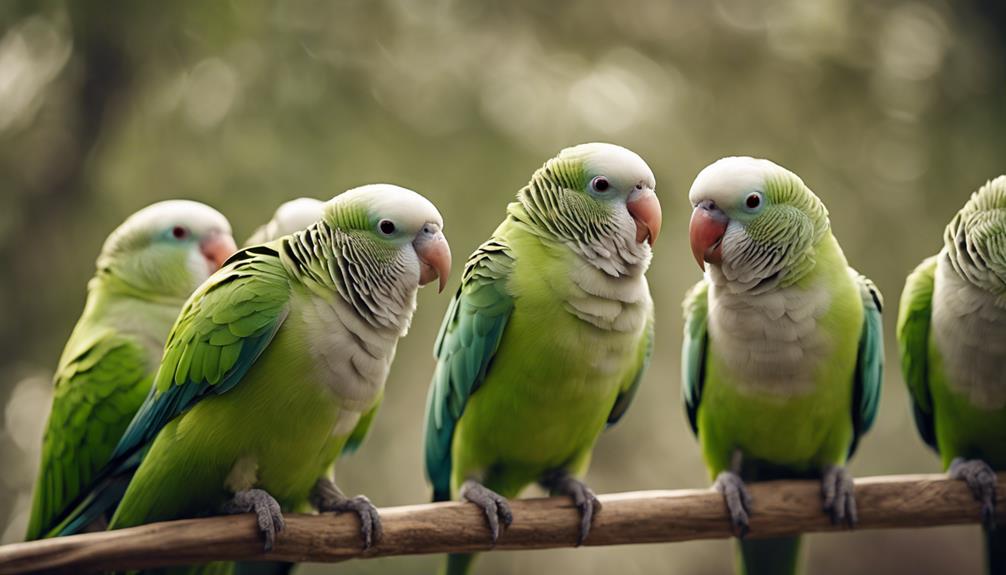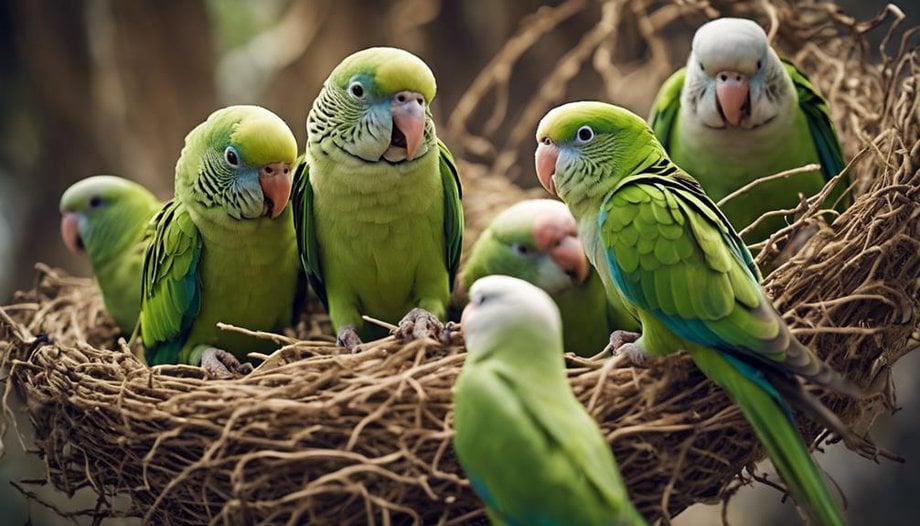Why Monk Parakeets Are Known for Their Social Structures

They are highly social birds that live in large colonies, with each colony consisting of multiple breeding pairs. These birds work together to build massive communal nests made of twigs, branches, and other materials. Monk parakeets also exhibit cooperative breeding, where non-breeding individuals help care for the young in the nest.
Their communication involves a variety of vocalizations, body language, and displays that help them convey information about food sources, potential threats, and social hierarchies within the colony. Overall, the complex social dynamics of monk parakeets make them fascinating subjects for study and observation.
Unique Nest-Building Behavior
Monk parakeets exhibit a remarkable ability to construct intricate communal nests, showcasing their exceptional social structure within the avian world. Their nest architecture is a marvel of avian engineering, often reaching considerable sizes and complexity. These nests, made from twigs, branches, and other plant materials, can house multiple pairs of breeding birds, highlighting the cooperative nature of these parakeets.
The foraging behavior of monk parakeets also plays a crucial role in nest-building. These birds work together to collect materials for nest construction, with individuals often seen flying back and forth, carrying twigs and other items in their beaks. This cooperative foraging behavior not only helps in gathering necessary materials efficiently but also strengthens the social bonds within the group.
Division of Labor Among Group Members

Demonstrating a sophisticated social structure, the division of labor among group members in monk parakeets is a key aspect of their cooperative behavior. Task specialization within the group is evident, with different members taking on specific roles that contribute to the overall functioning of the flock. This division of labor is crucial for their survival and successful group dynamics.
In monk parakeet communities, individuals exhibit distinct roles based on their strengths and abilities. Some birds excel at foraging for food, while others are skilled at nest-building or lookout duties. This task specialization ensures that each essential aspect of the group's needs is met efficiently, promoting the well-being of the entire flock.
Group dynamics among monk parakeets are finely tuned to support this division of labor. Clear communication and coordination allow members to work together seamlessly, maximizing productivity and resource utilization. Through a collaborative effort and understanding of each member's strengths, monk parakeets showcase a remarkable example of how task specialization enhances the collective success of the group.
Communication Strategies Within Flocks

Efficiently coordinating their actions through intricate vocalizations and body language, monk parakeets employ a sophisticated array of communication strategies within their flocks. These strategies are essential for their communal living and maintaining group cohesion.
Here are some key communication methods observed in monk parakeet flocks:
- Vocalization Patterns: Monk parakeets utilize a diverse range of vocalizations to convey different messages within the flock. These vocal signals can indicate danger, food sources, or even social bonding opportunities.
- Behavioral Cues: In addition to vocalizations, monk parakeets rely heavily on behavioral cues to communicate with one another. They use specific movements, such as head bobs, wing flutters, and beak gestures, to express intentions and emotions within the group.
- Coordination Signals: When engaging in group activities like foraging or building nests, monk parakeets exhibit synchronized movements that serve as coordination signals. These behaviors help them work efficiently as a team and achieve common goals.
Social Hierarchy and Leadership Roles

Within monk parakeet flocks, intricate social hierarchies emerge, dictating leadership roles and influencing group dynamics. These hierarchies are established through a combination of factors such as age, experience, and assertiveness. Leadership dynamics within monk parakeet flocks are essential for maintaining order and coordination during various activities like foraging and nesting.
The social hierarchy among monk parakeets isn't fixed and can change based on circumstances. Leadership roles are often assumed by individuals who display strong decision-making skills, effective communication, and the ability to resolve conflicts within the group. Such leaders play a crucial role in guiding the flock during movements and ensuring the safety of all members.
Social interactions within the flock are marked by intricate communication patterns that help reinforce the established hierarchy. Subordinate parakeets often defer to dominant individuals, maintaining a sense of order and cohesion within the group. These interactions contribute to the overall stability and functioning of the flock, highlighting the importance of leadership roles in monk parakeet societies.
Cooperative Foraging Techniques

Cooperative foraging techniques in monk parakeet flocks involve coordinated efforts to locate and obtain food resources efficiently. These intelligent birds exhibit remarkable behaviors during group foraging, demonstrating their strong social bonds and communication tactics:
- Information Sharing: Monk parakeets engage in sharing vital information about food sources within the flock. They use distinct calls and body language to alert others about the location of food, ensuring that all members benefit from the discovery.
- Collaborative Feeding: When a food source is found, monk parakeets work together to access it. They take turns feeding, allowing each bird a fair opportunity to replenish their energy reserves.
- Safety in Numbers: Group foraging provides safety advantages for monk parakeets. By working together, they can watch out for predators more effectively, decreasing the risk of an attack while feeding.
These cooperative foraging strategies highlight the intricate social dynamics and collective intelligence of monk parakeet flocks in their quest for sustenance.
Defense Mechanisms Against Predators

Monk parakeets exhibit a keen predation risk perception, swiftly responding to potential threats in their environment. Their nest location strategies are carefully chosen, often selecting spots that offer both protection and visibility.
When a predator is detected, these parakeets unleash group alarm calls, alerting others in the vicinity and coordinating a collective defense.
Predation Risk Perception
Perceiving potential threats, monk parakeets exhibit a variety of defense mechanisms against predators to ensure their safety within their social structures. These defense mechanisms are crucial for the survival of the group.
Here are some key strategies they employ:
- Risk Assessment: Monk parakeets engage in continuous risk assessment to evaluate potential dangers in their environment. This allows them to react promptly to any perceived threats.
- Group Vigilance: They rely on group vigilance, where multiple members of the flock actively scan the surroundings for predators. This collective effort increases their chances of detecting danger early.
- Alarm Calls: Monk parakeets use distinct alarm calls to alert the group about approaching predators. This communication helps in coordinating group responses and initiating evasive actions swiftly.
Nest Location Strategies
In response to potential threats, monk parakeets strategically select nest locations to enhance their protection against predators, utilizing their keen awareness of surroundings and social dynamics. Nesting preferences and environmental factors play a crucial role in their decision-making process. They often choose locations that offer natural barriers such as thorny bushes or tall trees, making it harder for predators to access their nests. Moreover, population density and competition dynamics within the group influence the choice of nest location. Monk parakeets tend to avoid areas with high competition or where other bird species are abundant, as this could increase the risk of predation. By carefully considering these factors, monk parakeets increase their chances of successfully raising their young and maintaining a secure environment within their social structure.
| Nest Location Strategies | |
|---|---|
| Natural barriers | Population density |
| Competition dynamics | Avoidance of predators |
| Environmental factors | Social dynamics |
Group Alarm Calls
Group alarm calls serve as a fundamental defense mechanism utilized by monk parakeets to alert each other of potential predators in their vicinity. When a threat is detected, the parakeet group engages in a series of vocal interactions to communicate the danger effectively. This coordinated response helps increase the chances of survival for the entire group by warning individuals to take cover or flee.
The group bonding among monk parakeets is strengthened through these alarm calls, fostering a sense of unity and cooperation essential for their collective defense against predators. Through their vocal interactions during alarm situations, monk parakeets showcase the intricate ways in which they rely on each other to navigate the challenges of their environment.
Benefits of Social Cohesion in Survival

Monk parakeets exhibit a remarkable capacity for forming strong social bonds within their groups. These connections play a crucial role in enhancing the survival prospects of the entire flock.
Through coordinated group cooperation, monk parakeets can effectively boost their resilience against various environmental challenges.
Social Bonds Enhance Survival
Thriving in the interconnected web of their community, monk parakeets exemplify how social bonds significantly enhance their survival in the wild.
Behavior studies have shown how social cohesion among monk parakeets provides them with survival advantages:
- Predator Defense: When faced with predators, monk parakeets in a cohesive group can alert each other swiftly, increasing their chances of evading danger.
- Resource Sharing: Social bonds enable monk parakeets to share information about food sources and nesting spots, ensuring collective well-being.
- Temperature Regulation: By huddling together during cold weather, monk parakeets conserve body heat and maintain warmth, a behavior crucial for their survival in harsh environments.
These findings underscore the vital role of social bonds in enhancing monk parakeets' resilience and overall survival.
Group Cooperation Boosts Resilience
In their natural habitats, monk parakeets exhibit heightened resilience through cooperative behaviors that foster social cohesion and enhance overall survival. Group dynamics among monk parakeets play a crucial role in their ability to adapt and thrive in diverse environments. By working together, these birds increase their chances of finding food, building nests, and protecting themselves from predators. Social behavior is not just a mere interaction; it is a strategic adaptation that ensures the collective well-being of the group. Through coordinated efforts and communication, monk parakeets exemplify how unity strengthens resilience in the face of challenges. Understanding the significance of group cooperation sheds light on the remarkable survival strategies these birds employ.
| Benefits of Group Cooperation | |
|---|---|
| Enhanced Resilience | Improved Adaptation |
| Strengthened Unity | Collective Survival |
Frequently Asked Questions
How Do Monk Parakeets Choose Their Mates Within Their Social Structures?
Monk parakeets, within their intricate social hierarchies, choose mates through elaborate courtship rituals. Males showcase their plumage and vocal prowess to attract females. Once a pair forms, they work together to build and maintain their nest.
What Role Do Individual Personalities Play in the Social Dynamics of Monk Parakeet Flocks?
Individual personalities in monk parakeet flocks significantly influence group dynamics. Behavioral traits shape social hierarchies, with communication styles reflecting these dynamics. Dominant birds may exhibit assertiveness, while more submissive ones display adaptability, all crucial for flock cohesion.
Do Monk Parakeets Exhibit Mourning Behaviors When a Member of Their Flock Dies?
In times of loss, monk parakeets display deep bonds within their flocks. Observers note mourning behaviors, such as solemn gatherings and shared vocalizations. These coping mechanisms reflect the group dynamics and social support crucial to their survival.
How Do Monk Parakeets Handle Conflicts or Disputes Within Their Groups?
Monk parakeets, known for their complex social structures, handle conflicts with intricate conflict resolution strategies. Group dynamics play a vital role in maintaining harmony, often involving vocalizations, physical displays, and cooperation to resolve disputes peacefully.
Are There Any Known Cases of Monk Parakeets Forming Alliances With Other Bird Species for Mutual Benefit?
Interspecies alliances among birds are rare but not unheard of. Monk parakeets have been observed forming cooperative relationships with other species, such as sharing nesting sites for mutual benefit and protection.











